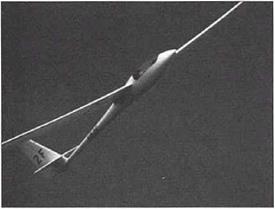In the Cockpit
Glider cockpits are far less complex than those of conventional airplanes. The pilot uses a stick rather than a control column, and the instrument panel is dominated by a big red knob that disconnects the tow rope when the glider has reached the proper height.
The instrument panel generally includes an airspeed indicator, an altimeter, a g-meter (to register the number of gs a pilot reaches during aerobatics, a subject we discuss in detail in Chapter 16, ”Cloud Dancing: Air Shows and Aerobatics“), and a variometer, a sensitive altimeter that quickly tells the pilot how many feet per minute she is climbing or descending. The variometer is important to a glider pilot, because it can be used in thermal flying to refine a flight path and take the very best advantage of the rising air.
A glider cockpit also features a spoiler control. With the lift of a lever, the pilot can raise narrow panels on the wings’ upper surfaces, and sometimes on both the upper and lower surfaces, that disrupt the smooth flow of air over the wing and destroy lift. At the same time, the spoilers add a dash of drag.
|
Turbulence If the glider pilot begins to climb too early before the tow plane has lifted off the runway, the upward tug on the tow rope can send the tow plane out of control. Once aloft, the tow rope can become too slack and can foul the glider’s controls. On rare occasions, the tow plane itself can be forced to release the tow rope, leaving the glider pilot with a dangling rope to get rid of before landing. |
When would the pilot want to destroy lift and increase drag? When landing. The spoilers can add a critical element of control for approaching the airport and maneuvering to a landing. That’s because gliders are naturally sleek and difficult to slow down. Without spoilers, a little extra speed or altitude can turn a safe landing into a crackup.
There’s one other instrument in the cockpit of a glider—a slip indicator. The slip indicator is a simply constructed instrument; it consists of a curved tube of fluid-filled glass with a ball resting in the bottom of the tube at the low part of the curve. The ball simply rolls to one side of the glass tube or the other, indicating whether a turn is ’’coordinated,11 meaning the tail follows directly behind the nose. In an uncoordinated turn, the tail either swings wide around the turn or slides inward to the inside of the turn. Either way, the sideways movement through the air adds drag, something that glider pilots try to avoid.
Gliders generally have simpler instrument panels than powered aircraft, and they often operate where elaborate communications equipment is not required. But for their simplicity, gliders demand an extra level of knowledge that powered pilots often take for granted.
|
E. C. Welch completes his task with a ’contest finish“(low and fast) over the Ephrata, Washington, airport. (Vince Miller) |
Glider pilots must develop a sixth sense about the behavior of wind, almost to the point of ”seeing“ the erratic curls and twists of the invisible air currents near mountains and beneath clouds.
What’s more, glider pilots must be very good at planning their approach to the airport and at ”stricking“ the landing, or doing it right the first time. Though off-airport landings happen sometimes and are generally done safely, glider pilots develop very precise skills that enable them to reach the landing strip every time.
|
Turbulence Gliders hive no engines, but don’t imagine that makes them unsafe. Glider pilots typically go flying only in good weather, which eliminates one of the most common causes of crashes— namely, bad weather. What’s more, gliders are easily controlled and able to land at low speeds, taking most of the risk out of an emergency landing. |














